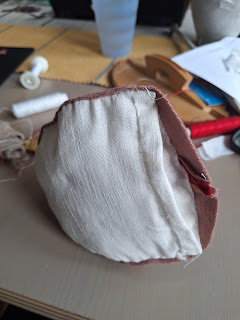I couldn't help myself, I just felt that I needed to make a hat for the landsknecht costume that I am making. One thing that helped me was that there are pattern available, so I didn't have to draft my own.
I ordered the pattern from Thimble&Plume - available at their etsy shop.
They don't only have the pattern, they also have a sew-along on their youtube channel, where you can follow each step in the constructions - available here
Since this was made from a commercial pattern, and that there is a youtube tutorial I won't post much about the construction here.
The HSM September challenge was about learning a new stitch, and following the instrucions from Thimble&Plume I learnt the fell stitch. I used that to attach the lining to outer fabric of the hat, previously I would have used a whip stitch, but the fell stitch is basically a whip stitch, but the other way around, and of course Thimble&Plume has a video tutorial describing the differences and taking you through them, available here.
The hat was made from the same wool that I have used for the whole outfit. The most fun part was blinging it out, and for that I used antique silk ribbon, some freshwater pearls and reproduction 16th century buttons that I had in my stash. I did buy some ostrich feathers from a sale, I had first planned to have more, but we will see if I will add more at a later time.
The baret with the silk bows.Detail of the pearls, feather and bling.
What the item is: A 16th century docken baret
How it fits the challenge: I learnt about the fell stitch to attach the lining to the outer fabric
Material: 0,8 m red wool, 0,5 m linen
Pattern: Thimble&Plume´s docken baret
Year: 1520s
Notions: bling, ostrich feathers, antique silk ribbon
How historically accurate is it? around 90%
Hours to complete: 6
First worn: Not yet
Total cost: around $40 (hard to say since everything except feathers were from my stash













































